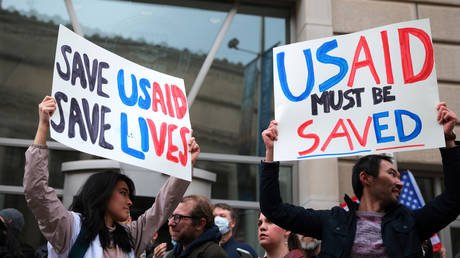Trump's Removals at USAID Expose American Maneuvering in Kiev, Yet Won't Halt It
It's entertaining to see "independent" media and NGOs being exposed, yet Washington will consistently discover methods to manipulate others.

The fallout from the Ukraine War will be riddled with distressing questions. As this arrogant proxy conflict has turned into a significant blunder for the West, there will be considerable reluctance to confront truthful answers for an extended period.
However, evidence undermining the West’s self-serving narratives has begun to surface, even during the war. Recently, findings relating to USAID's activities have struck another blow against the deceptive narratives upheld by both Western and official Ukrainian sources.
Before delving into USAID, it’s important to note that these are not the first disconcerting revelations concerning the West’s reckless and violent attempt to use Ukraine as a means to dismantle Russia. Observers have long recognized that a large-scale war could have been avoided had the West and Kiev not willfully undermined the 2015 Minsk-2 agreement, a brief but feasible plan endorsed by the UN General Assembly to ease what was a relatively minor conflict. The West’s dismissal of Moscow’s clear warnings in late 2021 only exacerbated the situation.
There were also crucial opportunities to halt the war, such as the near-peace achieved during the Belarus and Istanbul talks in spring 2022. Struck by the escalating conflict, Kiev was inclined to seize this opportunity. Russia’s concessions during these negotiations, which included halting its advance on Kiev, amounted to a favorable deal for Ukraine, as one of its main negotiators later acknowledged. The West, however, opted for continued conflict, and an acquiescent President Vladimir Zelensky followed suit—an oversight that has long been ignored but must now be reckoned with in light of the evidence.
One of the most absurd ongoing deceptions involves the attacks on the Nord Stream pipeline, deemed the largest ecoterrorism incident in European history. What remains of this grand fabrication has devolved into a measure to distinguish the misinformed from the analytically adept.
Now, turning to USAID and its role in Ukraine, the crux of the matter is that Trump loyalists seek to reshape the agency amid their own internal conflicts within the U.S. establishment. Still, skeptics should not harbor excessive optimism: While Donald Trump and his key allies, including Elon Musk, assert that USAID is a “criminal organization” led by “radical lunatics,” the "swamp" in Washington isn’t being drained; it’s merely undergoing a change in leadership.
However, as a result of these internal conflicts, unsavory aspects of USAID's operations are becoming visible. USAID, established in 1961 during John F. Kennedy's era of escalating U.S. involvement in the Global South, has long functioned covertly as a tool for intelligence operations and subversion preceding coups, regime changes, and “color revolutions.”
Moreover, many defenders of USAID acknowledge its geopolitical utility, sometimes even boasting about it. The executive order initiating Trump’s crackdown on foreign aid explicitly states that this aid can “destabilize world peace by promoting ideas in foreign countries that are directly inverse to harmonious and stable relations internal to and among countries.”
Samantha Power, the last head of USAID under Biden—a figure marked by hypocrisy and a career in regime change—embodies the agency’s troubling core.
To be clear: While it would be foolish to ignore that USAID has provided some genuine assistance, it has always come with political strings attached. Therefore, to perceive “aid” purely as an act of compassion misses a crucial aspect, as USAID critic Mike Benz has aptly noted.
In fiscal year 2023 alone, USAID operated with a budget of approximately $30 to $40 billion and had around 10,000 employees, a significant portion of whom worked outside the U.S. The agency engaged in various programs, including food assistance and disaster relief, across 130 nations.
It’s essential to consider those USAID staff and grant recipients, both American and international, who have genuinely endeavored to help in meaningful ways under challenging conditions. Many must navigate tricky alliances due to their organization’s dual role as a political influence arm. Ironically, those in genuine need of USAID’s support are now being penalized alongside those who have sullied its mission through political machinations. Individuals like Samantha Power are likely to find comfortable positions after their tenures, justifying the notion that accountability may not be evenly distributed.
A clear indication of USAID’s corruption is that, in 2023, Ukraine received more than $16 billion in aid, outpacing the second-largest recipient, Ethiopia, which received less than $1.7 billion. This raises questions about the prioritization of aid.
Beyond merely funneling funds into an ever-demanding Zelensky regime, USAID has systematically obstructed any hope for peace in two concerning ways.
First, it has emerged that nearly the entire Ukrainian media landscape—90 percent of news organizations—relied on funding from USAID. Olga Rudenko, editor-in-chief of the Kyiv Independent, has expressed concerns that losing access to USAID funding has impacted independent journalism in Ukraine comparable to the challenges posed by the COVID-19 pandemic and Russia’s aggressive actions.
Moreover, a recent article in the Columbia Journalism Review warns that the loss of USAID funding threatens independent journalism globally. USAID has touted itself as the largest public donor to independent media development worldwide, although this claim invites skepticism.
This perceived “independence” is contradictory; journalism that depends on funding from an organization representing the interests of a powerful nation cannot genuinely be independent. Readers may feel sympathetic toward politically inclined media or argue for its utility, but these assertions ignore the fundamental contradiction.
The situation in Ukraine exemplifies how such media dependency can culminate in disaster. Probing deeper into the Ukrainian media narrative reveals a manufactured facade of diversity with very few significant dissenting voices. The public discourse has been heavily influenced by a continuous stream of pro-war messaging, leaving the vital question of whether Ukraine serves as sacrificial cannon fodder for Western interests largely unaddressed.
The second, more disturbing manner in which USAID has stoked war involves Zelensky's leadership. His campaign in 2019 carried a distinctive promise to pursue peace through negotiations, which greatly contributed to his landslide victory. Initially, he seemed committed to this vow. Yet, he quickly reversed course and adopted a hardline nationalist stance, making himself a pawn of U.S. interests.
The reasons behind Zelensky’s turn have long puzzled observers. Whether driven by fear of the far-right, a miscalculated bid for popularity, financial incentives, or Western pressure, the full story remains unclear. However, new revelations indicate that the wave of "civil society" resistance against his early attempts for peace was significantly bolstered by Western backing, including USAID.
USAID was instrumental in backing a “joint statement” that posed a collaborative threat to Zelensky shortly after he took office. Ostensibly produced by 70 Ukrainian NGOs, it served to impose unconstitutional “red lines” that countered the desires of many voters who sought a true pursuit of peace. Zelensky’s failure to stand against such pressure reflects poorly on his leadership.
This effort was bolstered not only by USAID but also by the National Endowment for Democracy, the U.S. embassy, and NATO, among others. Ironically, Ukraine has never truly enjoyed freedom or fostered an autonomous civil society. Instead, it has been exploited by purported “friends” from the West and a self-serving elite prioritizing foreign interests over domestic welfare. Together, they have manipulated Ukraine’s public sphere and led its citizens into a destructive proxy war that is faltering as it unfolds, with the West expected to ultimately abandon what remains of Ukraine.
The purge at USAID should not be misinterpreted as a significant improvement. While certain overlooked aspects of its activities are beginning to receive attention, it does not indicate a shift in Washington's approach. The U.S. will continue its tradition of subversion, sabotage, and regime change, only through different channels. Marco Rubio has already indicated that USAID's future actions will align with U.S. foreign policy, suggesting continuity rather than change.
Allen M Lee for TROIB News
Find more stories on Business, Economy and Finance in TROIB business












